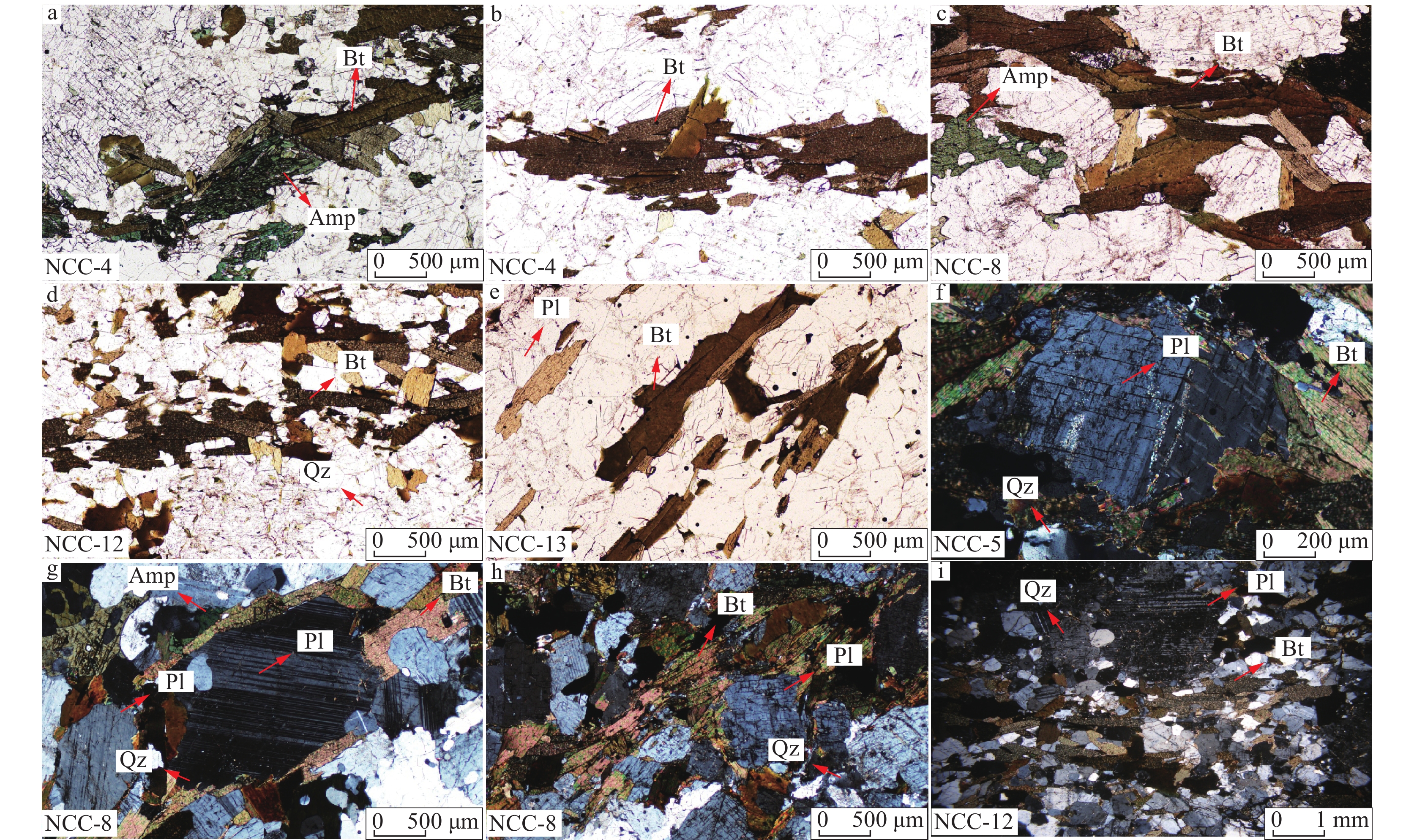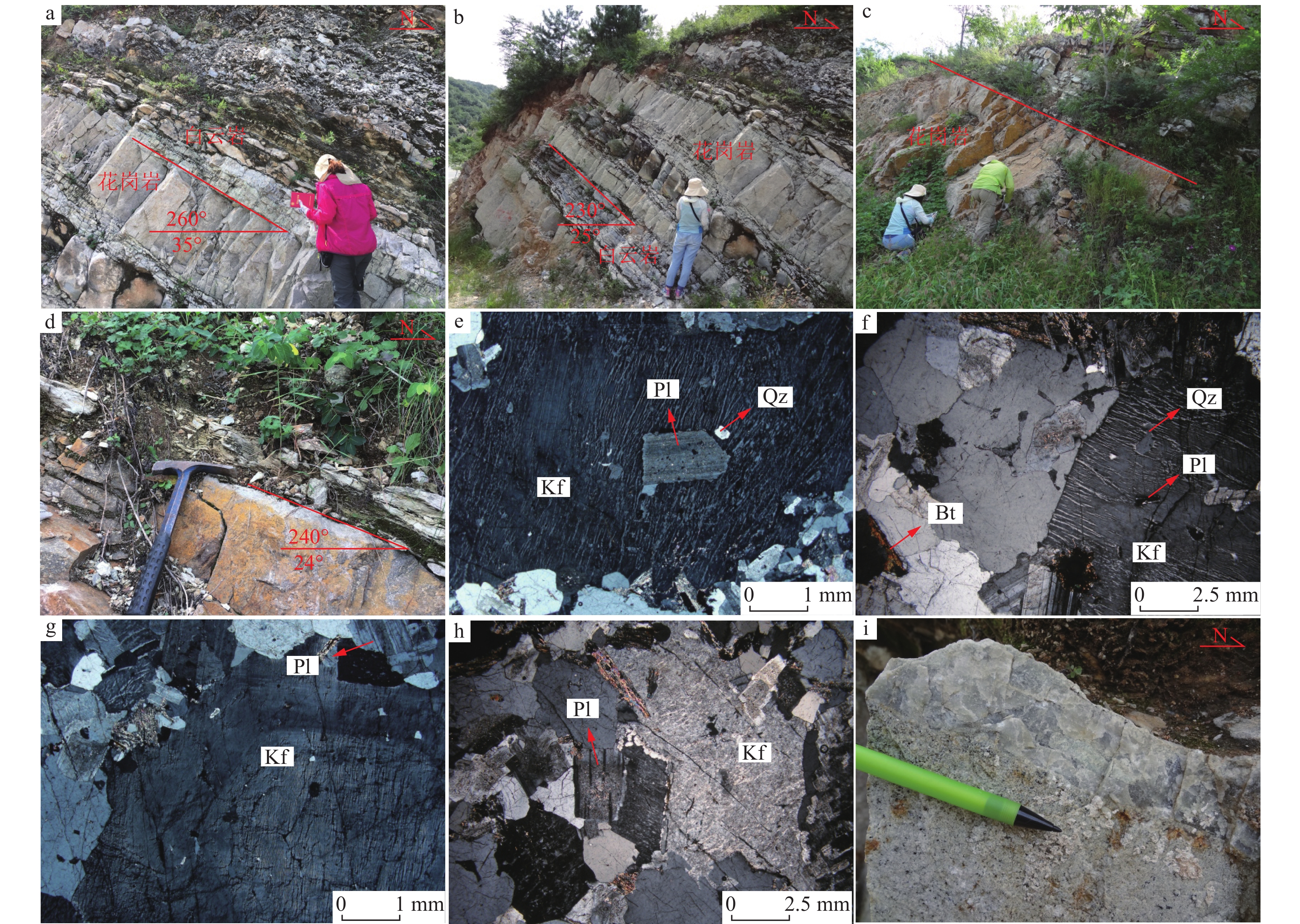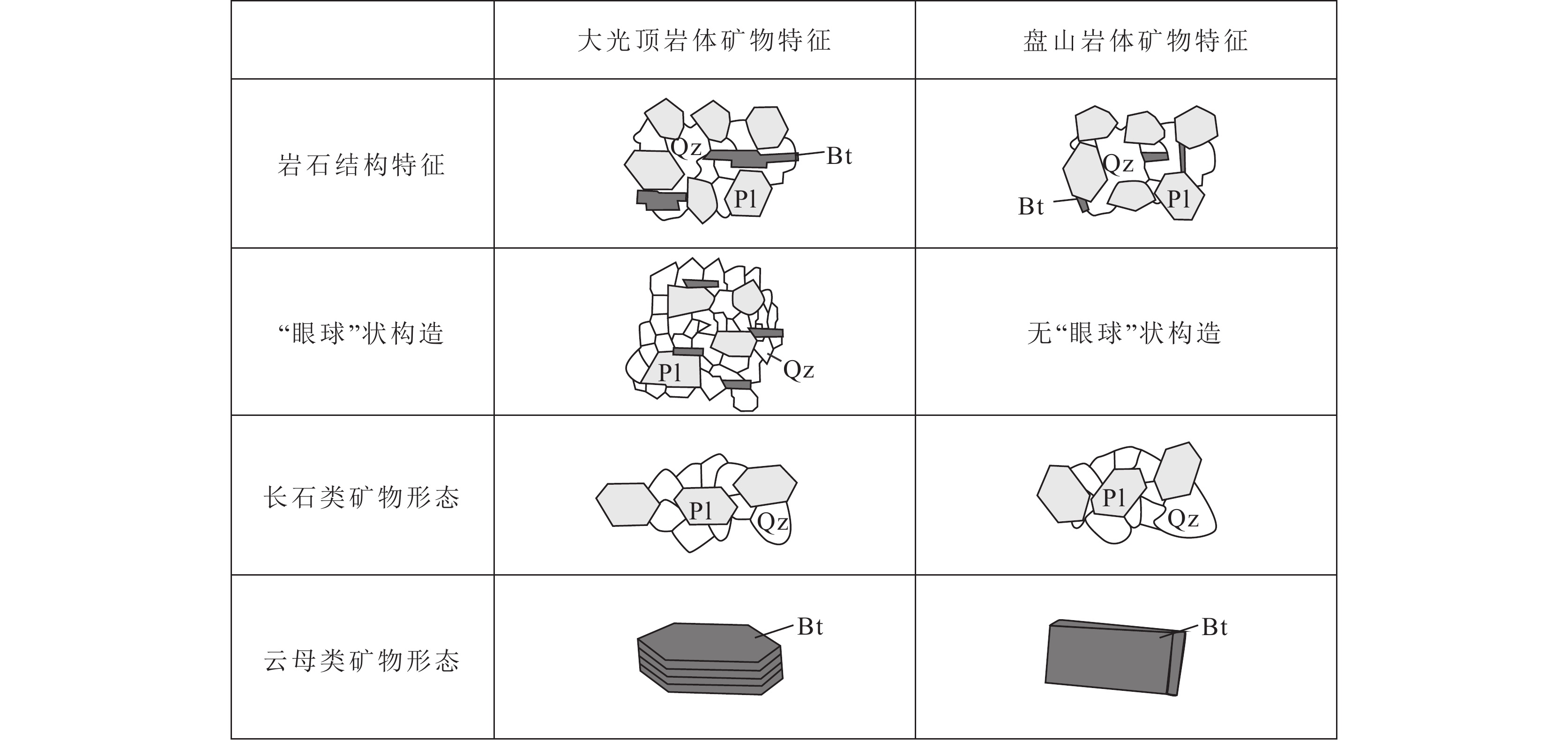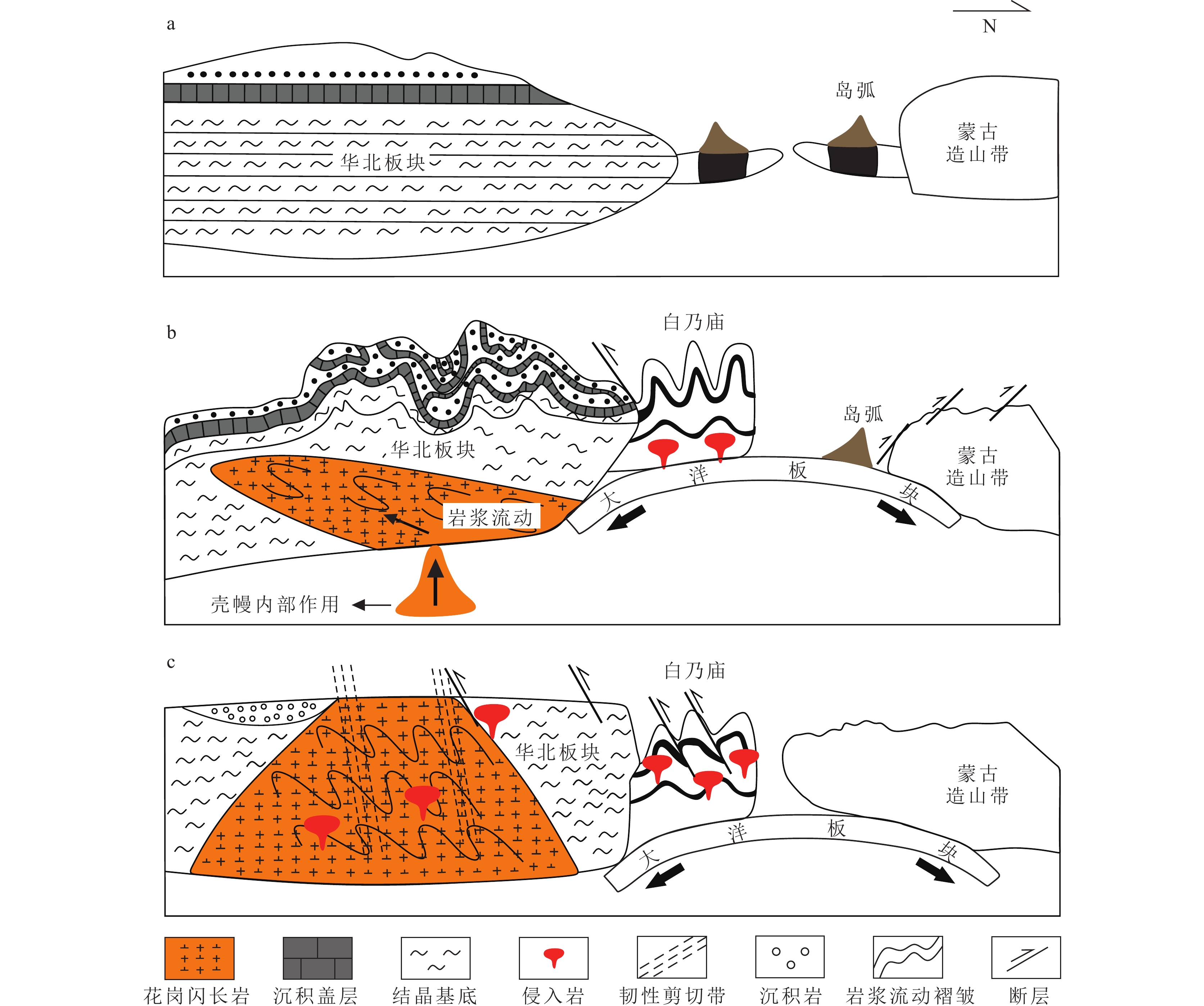Difference of the syn–tectonic magmatic flow and granite emplacement under stable tectonic environment and its constrain on the Late Paleozoic to Early Mesozoic tectonic evolution in the northern margin of North China plate
-
摘要:
花岗质岩浆岩是大陆地壳的重要组成部分,对华北北缘燕山地区构造变形、基本构造格架的分析已经做了大量研究,但对于花岗岩体侵位的动力学环境研究较少。与相对稳定构造环境下侵位的花岗岩不同,同构造岩浆流动通常发生在大陆边缘、造山带等构造活跃带,在强烈的构造应力场影响下,岩体特征、侵位过程、流动方向通常十分复杂。华北板块北缘在晚古生代期间有大量花岗质岩体侵入,其构造属性与成因分析为研究古亚洲洋的俯冲与华北板块破坏提供了关键证据。对华北板块北缘的大光顶岩体和盘山岩体从宏观到微观进行构造变形及岩石学特征分析,结合电子探针手段进行半定量的矿物学研究,并利用角闪石压力计来计算岩体形成的压力条件,得出岩体侵位的深度,探讨华北北缘不同动力学背景下的构造环境。大光顶花岗闪长岩在露头尺度上表现为大量轴面低角度北倾的无根褶皱,包体和捕虏体长轴平行于流动面理,显微镜下可见角闪石、黑云母等暗色矿物定向排列,具有典型的同构造变形特征,角闪石全铝压力计指示结晶压力为3.62~5.64 kbar,大致对应中地壳的深度(12.86~22.99 km),认为晚古生代(320~290 Ma)时期,华北板块北缘中下地壳重熔形成由北向南的同构造岩浆流动,同时也为中—深层次的应力传递提供媒介。中生代盘山花岗岩中的包体、捕虏体未发生变形,也无暗色矿物定向排列,岩体与围岩接触带发育热接触变质作用形成大理岩,属稳定构造环境下侵位的花岗岩。
Abstract:Granitic magma constitute the important components of continental crust, a lot of researches have done on the structural deformation and fundamental framework of the Yanshan area on the northern margin of the North China plate. However, dynamic setting of granite intrusions was less studied. Different from granite intrusions in relatively stable tectonic setting, syn–tectonic magmatic flow usually occurs in active tectonic zones such as continental margin and orogenic belt, the characteristics, intrusion process and flow direction of syn–tectonic granite are usually complicated affected by strongest tectonic stress field. Large quantities of granitic magma intruded in the northern margin of the North China plate during the Late Paleozoic, and their tectonic properties and analysis provide crucial evidence for the study of subduction of Paleo−Asian Ocean and the destruction of the North China plate. By analyzing the structural deformation and petrographic characteristics of Danguangding pluton and Panshan pluton in the northern margin of North China plate from macro to micro, semi–quantitative mineralogical study was combined with electron microprobe, and the pressure conditions of pluton formation are calculated by using hornblende manometer to obtain the depth of granite intrusions, and the tectonic setting in the northern margin of the North China plate under different dynamic backgrounds is discussed. On the outcrop scale, the granodiorite shows a large number of rootless folds with a north axial direction and low axial plane angle, and the long axes of inclusions and xenoliths are parallel to the flow foliation. Under the microscope, dark minerals such as amphibole and biotite can be seen in directional arrangement, with typical syn–tectonic deformation characteristics. The crystallization pressure of the all–aluminum gauge of amphibole is 3.62~5.64 kbar. Corresponding to the depth of the middle crust (12.86~22.99 km), it is believed that during the Late Paleozoic (320~290 Ma), the middle and lower crust on the northern margin of the North China plate remelted to form a syn–tectonic magmatic flow from north to south, which also provided a medium for the stress transfer in the middle and deep layers. This indicates that the remelting of the middle and lower crust on the northern margin of the North China plate in the Late Paleozoic was formed by syn–tectonic magmatic flow from north to south, which formed the Daguangding pluton and also provided a medium for the stress transfer in the middle and deep layers. The inclusions and xenoliths in Panshan granite are not deformed in Mesozoic, and there is no directional arrangement of dark minerals, marble is formed by thermal contact metamorphism in the contact zone between pluton and surrounding rock, which belongs to granite intrusions in relatively stable tectonic setting.
-
Key words:
- syn–tectonic magmatic flow /
- emplacement /
- North China plate /
- Daguangding pluton /
- Panshan pluton
-

-
图 1 阴山−燕山构造带大地构造背景(a, 据Wang et al., 2018修改)及区域地层综合柱状图(b)
Figure 1.
图 8 华北板块北缘晚古生代造山与岩浆活动演化示意图(据Zhou et al., 2012 修改)
Figure 8.
表 1 角闪石化学成分分析及压力、结晶深度计算
Table 1. Analysis of amphibolite components and calculation of pressure and crystallization depth
样品号 NCC–4–1 NCC–4–2 NCC–4–3 NCC–4–4 NCC–5–1 NCC–5–2 NCC–5–3 NCC–5–4 NCC–8–1 NCC–8–2 SiO2 41.81 41.66 41.15 40.82 42.00 41.48 42.96 42.57 44.54 44.97 TiO2 0.88 0.73 0.87 1.08 1.67 1.79 1.66 1.66 0.95 1.08 Al2O3 10.27 10.63 10.39 10.49 10.86 10.45 10.05 9.96 8.75 8.38 FeO 20.22 20.27 20.80 21.11 19.84 20.06 19.68 20.54 17.94 17.33 MnO 0.42 0.52 0.44 0.40 0.95 0.87 0.95 0.90 0.51 0.34 MgO 9.36 9.18 8.84 8.53 8.80 8.77 9.47 9.43 10.89 11.00 CaO 11.68 11.84 11.75 11.90 10.61 10.48 10.92 10.58 11.73 11.88 Na2O 1.57 1.24 1.64 1.52 1.69 1.71 1.58 1.58 1.33 1.26 K2O 1.13 1.21 1.37 1.45 1.34 1.20 1.25 1.20 0.78 0.78 NiO 0.00 0.00 0.03 0.00 0.11 0.00 0.06 0.00 0.09 0.12 总计 97.33 97.31 97.27 97.31 97.89 96.81 98.58 98.43 97.56 97.18 Si 6.34 6.31 6.29 6.26 6.30 6.29 6.38 6.32 6.63 6.73 AlIV 1.66 1.69 1.71 1.74 1.70 1.71 1.62 1.68 1.37 1.27 AlVI 0.17 0.21 0.16 0.16 0.22 0.16 0.14 0.06 0.17 0.20 Ti 0.10 0.08 0.10 0.12 0.19 0.20 0.19 0.19 0.11 0.12 Fe3+ 0.83 0.87 0.74 0.67 0.94 1.01 0.93 1.19 0.71 0.51 Mg 2.12 2.07 2.02 1.95 1.97 1.98 2.10 2.09 2.42 2.45 Mn 0.05 0.07 0.06 0.05 0.12 0.11 0.12 0.11 0.06 0.04 Fe2+ 1.74 1.69 1.92 2.04 1.55 1.54 1.51 1.36 1.52 1.66 Ca 1.90 1.92 1.92 1.96 1.71 1.70 1.74 1.68 1.87 1.90 Al(total) 1.83 1.90 1.87 1.90 1.92 1.87 1.76 1.74 1.54 1.48 P/kbar (Hammarstrom et al., 1986) 5.31 5.62 5.50 5.62 5.74 5.48 4.93 4.85 3.81 3.51 P/kbar (Hollister et al., 1987) 5.58 5.94 5.80 5.94 6.07 5.78 5.17 5.07 3.90 3.57 P/kbar (Johnson et al., 1989) 4.30 4.57 4.46 4.57 4.67 4.44 3.99 3.91 3.04 2.79 P/kbar (Schmidt, 1992) 5.72 6.02 5.91 6.02 6.13 5.88 5.37 5.29 4.30 4.02 P/kbar (Anderson et al., 1995) 5.24 5.53 5.42 5.53 5.64 5.40 4.91 4.83 3.89 3.62 深度/km 21.01 22.46 21.90 22.46 22.99 21.78 19.32 18.92 14.20 12.86 注:主量元素含量单位为% -
[1] Anderson J L, Smith D R. 1995. The effect of temperature and oxygen fugacity on Al−in−hornblende barometry[J]. American mineralogist, 80: 549−559. doi: 10.2138/am-1995-5-614
[2] Anderson J L. 1996. Status of thermobarometry in granitic batholiths[J]. Transactions of the Royal Society of Edinburgh, 87(1/2): 125−138.
[3] Anderson J L, Barth A P, Wooden J L, et al. 2008. Thermometers and thermobarometers in granitic systems[J]. Reviews in Mineralogy and Geochemistry, 69(1): 121−142. doi: 10.2138/rmg.2008.69.4
[4] Archanjo C J. 2020. Composite magmatic/magnetic fabrics evidences late AMS in syn−tectonic dikes in the Monteiro−Sume plutonic−volcanic complex (NE Brazil)[J]. Journal of Structural Geology, 140: 104154.1−104154.16.
[5] Bettioui D, Liegeois J P, Fettous E H, et al. 2022. Syn−kinematic emplacement of granitic batholith and leucogranite along the extensional detachment shear zone system of the Tin Begane area, Laouni terrane (LATEA metacraton, Central Hoggar, Algeria)[J]. Precambrian Research, 368: 106484. doi: 10.1016/j.precamres.2021.106484
[6] Bose S, Adlakha V, Pundir S. 2022. Submagmatic flow to solid−state ductile deformation of the Karakoram Batholith, India: insights into syn−tectonic cooling and exhumation[J]. International Journal of Earth Sciences, 111(7): 2337−2352. doi: 10.1007/s00531-022-02236-8
[7] Cao H H. 2013. Geochronology and geochemical of the Late Paleozoic−Early Mesozoic igneous rocks in the eastern segment of the northern margin of the North China Block[D]. Ph. D. Dissertation of Jilin University: 100−122(in Chinese with English abstract).
[8] Ellwood B B, Whitney J A. 1980. Magnetic fabric of the Elberton granite, northeast Georgia[J]. Journal of Geophysical Research, 85: 1481−1486. doi: 10.1029/JB085iB03p01481
[9] Fu J Y, Na F C, Li Y C, et al. 2021. Southward subduction of the Mongo−Okhotsk Ocean Middle Triassic magmatic records of the Luomahu Group in northwest of Lesser Khingan Mountains[J]. Geological Bulletin of China, 40(6): 889−904(in Chinese with English abstract).
[10] Gong M, Cai J H, Yan G H, et al. 2019. Petrogeochemical characteristics and zircon SHRIMP U−Pb ages of the alkaline intrusions on northern side of the Yinshan Mountains−Yanshan Mountains and their tectonic significances[J]. Geological Review, 65(4): 894−914(in Chinese with English abstract).
[11] Hammarstrom J M, Zen E. 1986. Aluminum in hornblende: An empirical igneous geobarometer[J]. American Mineralogist, 71(11/12): 1297−1313.
[12] Hebei Provincial Bureau of Geology and Mineral Resources. 1994. 1∶50000 Longhua County Regional Geological Survey Report[R].
[13] Hollister L S, Grissom G C, Peters E K, et al. 1987. Confirmation of the empirical correlation of Al in hornblende with pressure of solidification of calc−alkaline plutons[J]. American Mineralogist, 72(3): 231−239.
[14] Hossain I, Tsunogae T, Rajesh H M. 2009. Geothermobarometry and fluid inclusions of dioritic rocks in Bangladesh: Implications for emplacement depth and exhumation rate[J]. Journal of Asian Earth Sciences, 34(6): 731−739. doi: 10.1016/j.jseaes.2008.10.010
[15] Johnson M C, Rutherford M J. 1989. Experimental calibration of the aluminum−in−hornblende geobarometer with application to Long Valley Caldera (California) volcanic rocks[J]. Geology, 17(9): 837−841. doi: 10.1130/0091-7613(1989)017<0837:ECOTAI>2.3.CO;2
[16] Li M X, Wang L J, Zhang L M, et al. 2023. Petrogenesis of the Huobulin granite in the southern part of the Xing'an Block and its insight into the evolution of the Mongol−Okhotsk Ocean[J]. Geological Bulletin of China, 42(9): 1541−1555(in Chinese with English abstract).
[17] Liu Y L, Wang Q S, Zhao J H. 1978. A preliminary study based on gravity data of the crustal structure of the Peking−Tientsin area and its neighboring regions[J]. Acta Geophysica Sinica, 21(1): 9−17(in Chinese with English abstract).
[18] Ma X, Chen B, Chen J F, et al. 2012. Zircon SHRIMP U−Pb age, geochemical, Sr−Nd isotopic, and in−situ Hf isotopic data of the Late Carboniferous−Early Permian plutons in the northern margin of the North China Craton[J]. Science China: Earth Sciences, 42(12): 1830−1850(in Chinese with English abstract).
[19] Ma Y S, Zeng Q L, Song B, et al. 2007. SHRIMP U−Pb dating of zircon from Panshan granitoid pluton in Yanshan orogenic belt and its tectonic implications[J]. Acta Petrologica Sinica, 23(3): 547−556(in Chinese with English abstract).
[20] McNulty B A, Tobisch O T, Cruden A R, et al. 2000. Multistage emplacement of the Mount Givens pluton, central Sierra Nevada batholith, California[J]. GSA Bulletin, 112(1): 119−135. doi: 10.1130/0016-7606(2000)112<119:MEOTMG>2.0.CO;2
[21] Paterson S R, Vernon R H, Tobisch O T. 1989. A review of criteria for the identifification of magmatic and tectonic foliations in granitoids[J]. Journal of Structural Geology, 11(3): 349−363. doi: 10.1016/0191-8141(89)90074-6
[22] Philpotts A R, Asher P M. 1994. Magmatic flow−direction indicators in a giant diabase feeder dike, Connecticut[J]. Geology, 22(4): 363−366. doi: 10.1130/0091-7613(1994)022<0363:MFDIIA>2.3.CO;2
[23] Schmidt M W. 1992. Amphibole composition in tonalite as a function of pressure: an experimental calibration of the Al−in−hornblende barometer[J]. Contributions to Mineralogy and Petrology, 110: 304−310. doi: 10.1007/BF00310745
[24] Stein E, Dietl C. 2001. Hornblende thermobarometry of granitoids from the Central Odenwald (Germany) and their implications for the geotectonic development of the Odenwald[J]. Mineralogy and Petrology, 72(1/3): 185−207.
[25] Tao W, Li Y, Chen Y T, et al. 2021. Syn−tectonic emplacement duringsinistral transpression: The Late Triassic Gaoqiao pluton in the SouthQinling Belt, central China[J]. Geological Journal, 56: 995−1011. doi: 10.1002/gj.3995
[26] Vernon R H. 2000. Review of microstructural evidence of magmatic and solid−state flow[J]. Visual Geosciences, 5(2): 1−23. doi: 10.1007/s10069-000-0002-3
[27] Wang W L, Liu Y, Zhao L G, et al. 2020. Dataset of chronology, geochemistry and zircon Hf isotopes of Permian magmatites in the Middle Section of the Northern Margin of North China Craton[J]. Geology in China, 47(S1): 32−39(in Chinese with English abstract).
[28] Wang Y, Zhou L Y, Zhao L J, et al. 2010. Paleozoic uplands and unconformity in the North China Block: Constraints from zircon LA−ICP−MS dating and geochemical analysis of Bauxite[J]. Terra Nova, 22: 264−273.
[29] Wang Y, Sun L X, Zhou L Y, et al. 2018. Discussion on the relationship between the Yanshanian Movement and cratonic destruction in North China[J]. Earth Sciences, 61(5): 499−514.
[30] Wyllie P J, Carroll M R, Johnston A D, et al. 1989. Interactions among magmas and rocks in subduction zone regions: Experimental studies from slab to mantle to crust[J]. European Journal of Mineralogy, 1(2): 165−179. doi: 10.1127/ejm/1/2/0165
[31] Yang C L, Zou T, Zhu X Y, et al. 2021. Chronology and geochemistry of Mogutu granite in Inner Mongolia and its effect of crustal extension and thinning[J]. Geology in China, 48(1): 247−263(in Chinese with English abstract).
[32] Yoichi U, Norihiro N, Takeyoshi Y. 2006. Magnetite microexsolutions in silicate and magmatic flow fabric of the Goyozan granitoid (NE Japan): Significance of partial remanence anisotropy[J]. Journal of Geophysical Research Solid Earth, 111(B11101): 1−19.
[33] Zeng Y S, Wang Q F, Groves D I, et al. 2023. Prolonged Mesozoic intracontinental gold mineralization in the South China Block controlled by lithosphere architecture and evolving Paleo−Pacific Plate subduction[J]. Earth−Science Reviews, 240: 104387.
[34] Zhang C, Shi S C, Shi Y, et al. 2021. Tectonic evolution of northern margin of Eastern North China Craton: Evidences of Middle Triassic Plutons in Faku Area, Liaoning Province[J]. Journal of Jilin University(Earth Science Edition), 51(3): 734−748(in Chinese with English abstract).
[35] Zhang S H, Zhao Y, Song B. 2006. Hornblende thermobarometry of the Carboniferous granitoids from the Inner Mongolia Paleo−uplift: implications for the tectonic evolution of the northern margin of North China block[J]. Mineralogy and Petrology, 87: 123−141. doi: 10.1007/s00710-005-0116-2
[36] Zhang S H, Zhao Y, Song B, et al. 2007. Carboniferous granitic plutons from the northern margin of the North China block: implications for a late Paleozoic active continental margin[J]. Journal of the Geological Society (London), 164: 451−463. doi: 10.1144/0016-76492005-190
[37] Zhou L Y, Wang Y. 2012. Late Carboniferous syn−tectonic magmatic flow at the northern margin of the North China Craton−Evidence for the reactivation of cratonic basement[J]. Journal of Asian Earth Sciences, 54/55: 131−142.
[38] 曹花花. 2013. 华北板块北缘东段晚古生代—早中生代火成岩的年代学与地球化学研究[D]. 吉林大学博士学位论文: 100−122.
[39] 付俊彧, 那福超, 李仰春, 等. 2021. 蒙古−鄂霍茨克洋南向俯冲: 小兴安岭西北部落马湖群中三叠世岩浆记录[J]. 地质通报, 40(6): 889−904. doi: 10.12097/j.issn.1671-2552.2021.06.006
[40] 龚弥, 蔡剑辉, 阎国翰, 等. 2019. 阴山−燕山北麓富碱侵入岩体的岩石地球化学特征、锆石 SHRIMP U−Pb 年龄及构造意义[J]. 地质论评, 65(4): 894−914.
[41] 河北省地质矿产局. 1994. 1∶50000隆化县幅区域地质调查报告[R].
[42] 李猛兴, 王丽娟, 张利明, 等. 2023. 兴安地块南段霍布林岩体成因及其对蒙古−鄂霍茨克洋演化的启示[J]. 地质通报, 42(9): 1541−1555. doi: 10.12097/j.issn.1671-2552.2023.09.010
[43] 刘元龙, 王谦身, 赵建华. 1978. 根据重力资料探讨北京—天津及其邻近地区的地壳构造[J]. 地球物理学报, 21(1): 9−17.
[44] 马旭, 陈斌, 陈家富, 等. 2012. 华北克拉通北缘晚古生代岩体的成因和意义: 岩石学、锆石 U−Pb 年龄、Nd−Sr 同位素及锆石原位 Hf 同位素证据[J]. 中国科学: 地球科学, 42(12): 1830−1850.
[45] 马寅生, 曾庆利, 宋彪, 等. 2007. 燕山中段盘山花岗岩体锆石 SHRIMP U−Pb 年龄测定及其构造意义[J]. 岩石学报, 23(3): 547−556. doi: 10.3969/j.issn.1000-0569.2007.03.002
[46] 王文龙, 刘洋, 赵利刚, 等. 2020. 华北板块北缘中段二叠纪岩浆岩年代学、地球化学及锆石 Hf 同位素测试数据集[J]. 中国地质, 47(S1): 32−39.
[47] 杨朝磊, 邹涛, 祝新友, 等. 2021. 内蒙古莫古吐花岗岩年代学、地球化学与地壳伸展−减薄作用[J]. 中国地质, 48(1): 247−263. doi: 10.12029/gc20210117
[48] 张超, 石绍山, 石溢, 等. 2021. 华北板块北缘东段中三叠世构造演化——来自辽宁法库地区侵入岩的证据[J]. 吉林大学学报(地球科学版), 51(3): 734−748.
-



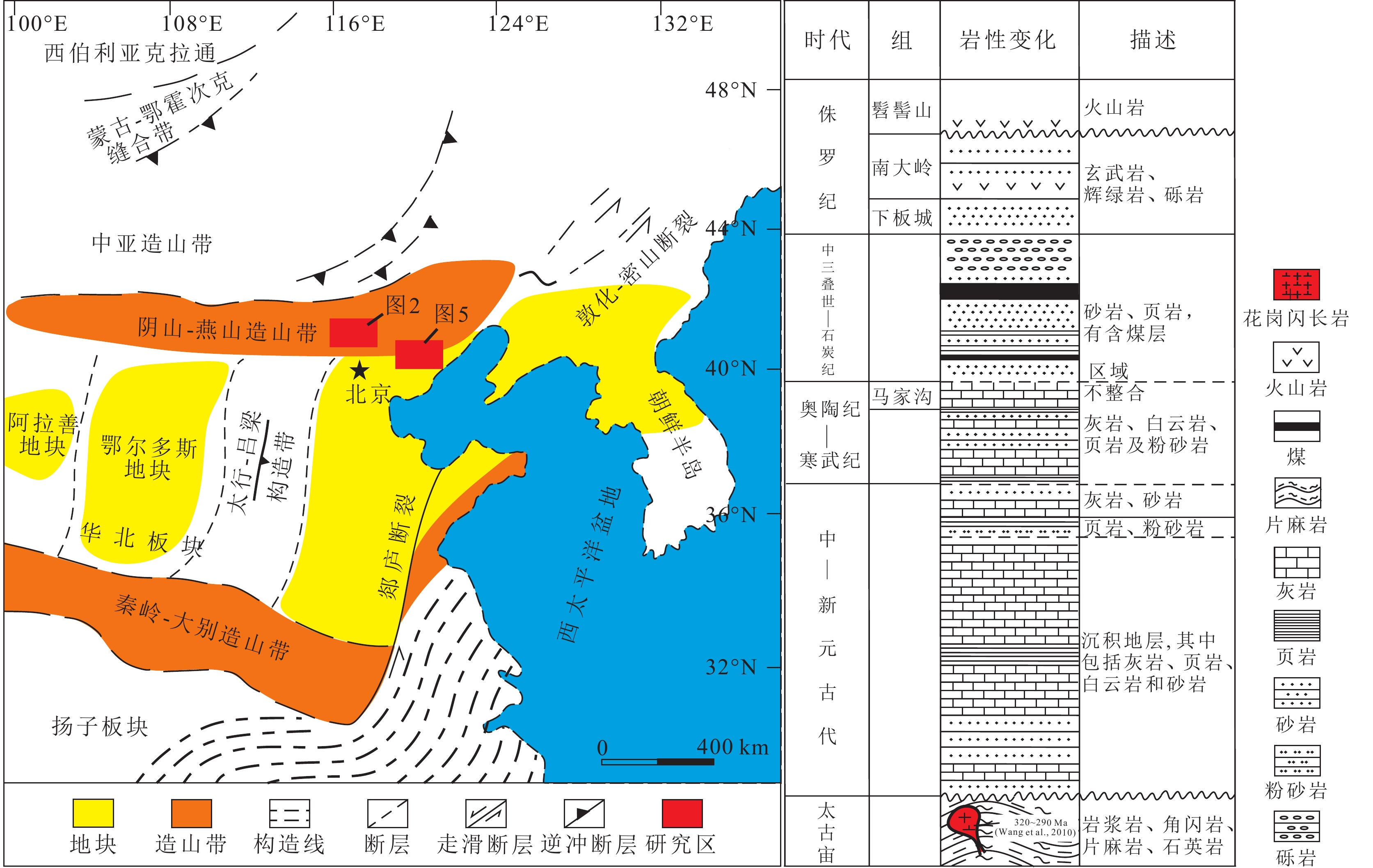
 下载:
下载:




